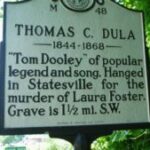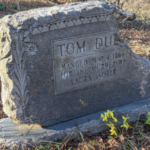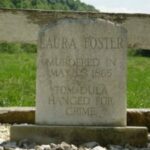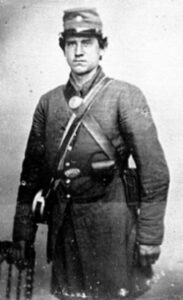Thomas C. Dula (June 22, 1845 – May 1, 1868) was a former Confederate soldier, who was tried, convicted, and hanged for the murder of his fiancée, Laura Foster. The trial and hanging received national publicity from newspapers such as The New York Times, thus turning Dula’s story into a folk legend.
While the murder happened in Wilkes County, the trial, conviction, and execution took place in Statesville, North Carolina. There was considerable controversy surrounding his conviction and execution. In subsequent years, a folk song was written (entitled “Tom Dooley,” based on the pronunciation in the local dialect), and many oral traditions were passed down, regarding the sensational occurrences surrounding the murder of Foster, and Dula’s subsequent execution. The Kingston Trio recorded a hit version of the murder ballad in 1958.
Tom Dula was born in Wilkes County, North Carolina, most likely the youngest of three brothers, with one younger sister, Eliza. The young Dula grew up, attended school, and “probably played with the female Fosters,” Ann (later Melton), and Laura, her younger cousin. As the children grew up, Tom and Ann apparently courted. Three months before his 18th birthday, on March 15, 1862, he joined the Confederate Army. Dula served as a private in Company K in the 42nd North Carolina Infantry Regiment until the war ended in 1865.
Upon returning from the war, Dula discovered that Ann had married James Melton. Given his reputation as something of a “ladies man,” it did not take Dula long to take up with young Laura. She and Dula decided to elope. On the night she was to meet Dula, about the 26th of May, 1866, she left her home, never to be seen alive again.
While it is not known for certain what happened that evening, many of the stories that have grown out of the folklore of the time implicate Ann Melton in some way. Some believe that Ann may have murdered Laura Foster because she was still in love with Dula and was jealous that Laura was marrying him; others believe that perhaps Dula knew or suspected that Ann had murdered Foster, but because he still loved Ann he refused to implicate her after he was arrested and took the blame for the murder. In fact, it was Ann’s word that led to the discovery of the girl’s body. Foster had been stabbed multiple times with a large knife. The gruesome nature of the murder captured the public’s attention, and led to the enduring notoriety of the crime.
The role of Dula in the slaying is unclear. He fled shortly after her body was found – when he was declared a suspect – working for a time for Colonel James Grayson, in Watauga County, before taking refuge across the state line in Trade, Tennessee. Grayson did help the Wilkes County posse bring Dula in, once his identity was discovered.
After Dula was arrested, former North Carolina Governor Zebulon Vance represented him pro bono, and maintained Dula’s innocence of the charges. He succeeded in having the trial moved from Wilkesboro to Statesville, as it was widely believed that Dula would not receive a fair trial in Wilkes County. Dula was convicted and, although he was given a new trial on appeal, he was convicted again. His supposed accomplice, Jack Keaton, was set free and, on Dula’s word, Melton was acquitted of the crime. As he stood on the gallows facing his death, he is reported to have said, “Gentlemen, do you see this hand? I didn’t harm a hair on the girl’s head.”
He was executed nearly two years after the murder of his fiancée, on May 1, 1868. His younger sister and her husband retrieved his body for burial after the execution.
Subsequently, much legend and folklore arose around the tragedy and the life of Tom Dula. Not the least of these tales has Dula surviving the war without a scratch, and Governor Zebulon Baird Vance making use of Dula’s supposed talents with a banjo for his own personal entertainment. Both Dula’s and Vance’s accounts, as well as Dula’s own military record, show this legend to be untrue; it persists nonetheless.
This trunk includes primary source documents and testimony from the trial that your students can act out and come to their own conclusions about the guilt or innocence of Tom Dula. Other lessons deal with folklore, folktales and history as well as examining a primary source document (a map) and writing.
download teacher materials PDF




